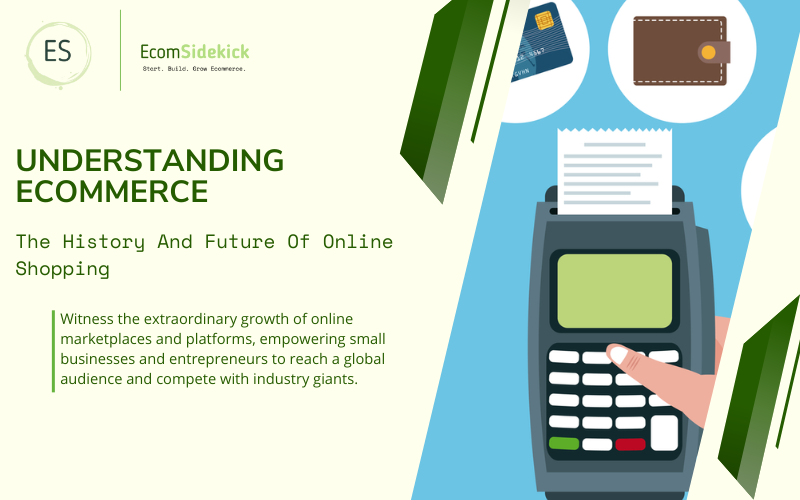Many people have participated in e-commerce without even knowing what it is. In its most basic form, e-commerce is online shopping. Of course, there is more to e-commerce but we will go into future detail throughout this article.
For those who are more serious about learning ecom, or starting your own ecommerce company, take a look at our how to start an ecommerce business article.
Now, let’s dive into history and future of online shopping.

Since its inception, e-commerce has been rapidly gaining popularity across the world. The main reason for this is convenience. You are able to look at all of the products available to you, read reviews, and buy yourself the best product for yourself all while sitting on the bus.
Online shopping has become a part of many people’s everyday lives. There are many factors that contribute to the rise of online shopping, some being convenience, the number of options, and the ability to read reviews of a product. It also became easier to shop online with the rise of online mobile banking.
A prime example of this rapid gain in e-commerce popularity is that customers spent online $870.78 billion with US merchants in 2021. This was up from the previous year when $752.86 billion was spent. These numbers are expected to rise over time as more and more people turn to online shopping.

The concept of e-commerce has been around since before the internet. Since then it has rapidly evolved into what we know today and will probably continue to change and adapt to meet the ever-changing online market.
In this article, we outline exactly what ecommerce is, what is its history, and what the future has in store for ecommerce. Of course, we cannot cover everything but we have tried to make it as simple and concise as possible.
History And Future Of Online Shopping: Understanding Ecommerce
Ecommerce is when electrical platforms are used for transactions. This is most commonly done over the internet and can be used for both buying and selling products.
For many people it is their preferred way of doing business, this is because e-commerce is available to both large companies and individuals. It is an easy way for an individual to sell a single item that would’ve otherwise gone to waste.
Some individuals are able to open up their own business online which they previously wouldn’t be able to do since it was expensive to open a physical store. Etsy is a great example of individuals creating small businesses to sell their handmade items. This means that people with very specific needs are able to find what they want, or commission someone to do it.
For businesses, e-commerce is a way to gain a larger customer base, Some businesses have transferred to being completely online instead of having a physical store as it is generally cheaper. Many businesses nowadays are starting online with the hope of gaining enough customers to open a physical store.

Ecommerce has made the process of buying and selling items more convenient than it has ever been. This is because it can be done literally anywhere and by anyone.
The rise in popularity of smartphones had given people access to the internet no matter where they are. This means that people can buy or sell their items when they are traveling, at work, or in bed.
Since online shopping is via the internet, it means that people have access to products from all over the world. While people still mainly buy domestically, buying from abroad rose to 21% in 2017 compared to 15% in 2015.
While e-commerce has made selling items easier, customers now have the ability to thoroughly research an item before purchasing. This means that businesses will need to know exactly what the customer wants in order to gain their business and beat out any competition.
The fast-paced nature of e-commerce also means that businesses will need to adapt not only their products but also their payment methods in order to appeal to customers. With the rise in cryptocurrency, some businesses began offering their products to be able to be purchased with cryptocurrency. The ease of platforms like Cash App and Paypal have launched us into a newer wave of operating small businesses.
While there are many e-commerce businesses, the ones that lead in popularity are Amazon and eBay. This is mainly because they serve e-commerce in different ways.
Amazon is a convenient way to get an assortment of items. You are able to buy from certain businesses and can expect your items to be delivered quickly.
Whereas eBay is an online auction site. There individual people are selling their items rather than businesses and it is typically a one-off. This means that people can pay more for an item they really want rather than at a set price.
History Of Online Shopping

E-commerce has completely changed from what it started out as. Since it can be dated as farther back than the internet, its beginnings are relatively simple.
These simple beginnings don’t mean that e-commerce didn’t completely change how we viewed online. Suddenly the internet was seen as something that can be profitable rather than informative or entertaining.
This mindset is rapidly evolving and the future of e-commerce looks bright, but in order to understand exactly how e-commerce can evolve, it is good to know how much it already has
The Early Years
Ecommerce can be traced back as far as the 1960s, specifically when Electronic Data Interchange (EDI) was introduced. This was created to allow data to be sent electronically without human intervention.
This data exchange was specifically used in the B2B community and allowed for invoices, orders, and other documents to be transferred digitally.
EDI “It was supposed to replace mail and fax because it made data exchange possible through digital transfer, without the need for human intervention.”
(Source: https://www.spiralytics.com/blog/past-present-future-ecommerce/)
The first concept of online shopping was created in 1979 by Michael Aldrich. After a trip to purchase groceries, he had the idea of doing so online and created a mock-up by hooking up his TV to a transaction processing computer via a telephone line.
Similar to EDI, this was marketed as a B2B system rather than a customer-based one. This is probably due to the fact that home computers weren’t that popular in the 1970s and 1980s so there was no need to market to such a small audience.
This however was about to change in 1990 when the World Wide Web was invented and allowed people from all over the world to communicate with each other. Suddenly a large market opened up for e-commerce that could be bought by the masses.
The Late 90s
The 1990s was when e-commerce began to take off, and many of the big e-commerce companies found their start in the early to mid-1990s.
This decade saw the first secure online purchases being made to the general public. E=-commerce began to be seen as convenient and easy with the help of the World Wide Web.
“In 1990 Tim Berners Lee and Robert Cailliau built a hypertext project called WorldWideWeb. Lee used a NeXT computer to create the first web server, as well as write the first web browser. In 1991, the web debuted as a publicly available service on the Internet. He then married the hypertext to the Internet and developed the URL, HTML, and HTTP.”
(Source: https://www.spiralytics.com/blog/past-present-future-ecommerce/)
One of the first e-commerce stores was launched in 1992, it was called Books Stacks Unlimited and allowed people to buy books online, today this company is more commonly known as Barnes & Noble.
Since many people were suddenly shopping online, security needed to be set up to ensure that it was done correctly. This is when Secure Socket Layers (SSL) encryption certificates were developed. These certificates showed that a site and business could be trusted with your transaction.
In a time when the main thing holding people back from online shopping was fear, this helped to show people that it was a trusted way of buying items and helped to calm their fears.
Online shopping became even easier in 1995 with the invention of search engines. This meant that people could find exactly what they want and which sites can offer it to them. One of the first most popular search engines was Yahoo! which was quickly followed by Google in 1998. Nowadays you can even shop in search engines with most of them having their own shopping tab.
1995 is when e-commerce really began to change with the creation of AuctionWeb, the first online auction site which would later change its name to eBay. This meant that not only could people buy items online, but they could also sell their own.
In 2002, eBay acquired PayPal to make shopping online even easier. With PayPal customers wouldn’t need to put in their card information every time they wanted to buy something. Instead, they just had to create a single account.

PayPal also made shopping online safer. Since people were buying from each other rather than a business, it meant that the chances of being scammed were much higher. Paypal allowed people to report scams and get their money back when previously they had little means of protecting their money.
Buying online also became more streamlined with PayPal as it allowed people to buy items in a currency different from their own. Customers didn’t have to worry about conversion rates since it was all done through one service.
In 1994, Cadabra Inc was founded. However, one year later they would change its name to Amazon. While Amazon is a household name nowadays, it started out as a simple online book store with them acquiring online booksellers in 1998.
Since its inception, Amazon has been changing how we view e-commerce. It gave businesses the opportunity to sell their own products through them rather than opening their own online store.
Amazon was also one of the first to offer affiliate marketing, this meant that people could make a commission off certain items if they convinced their audience to buy the item through Amazon.
Another way that Amazon changed the e-commerce landscape is through the use of a user review and rating system. By allowing people to review products they have already bought, it means that people can make an informed decision about whether or not they should buy this item. It also meant that people could do their own research about a certain product without leaving Amazon’s site.
Amazon has been rapidly growing in popularity and has become synonymous with online shopping. In 2015 alone Amazon accounted for more than half of all e-commerce growth and has clearly been rising in the years since.
“The ‘90s saw the first secure online purchases – one of which was a large pizza from Pizza Hut, and another was a Sting CD, sold by US retailer, NetMarket on 11 August 1994. The eCommerce industry quickly grew from this point onward. Simply look forward three years to the end of 1997 and Dell became the first company to announce a single day sales record of $1 million online.”
(Source: https://www.statementagency.com/blog/the-history-of-ecommerce/)
Early 2000s
The early 2000s is when people began to get permanent access to the internet. This was after the large growth of the personal computer in the 1990s. By having more people have access to the internet, it means the online shopping audience is much larger.
Some phones were able to access the internet since the 1990s but it had yet to gain mass popularity. In 2001, Amazon launched its first mobile site. This meant people could easily access Amazon on their phones and it would be scaled accordingly.
2003 saw the introduction of broadband and it was an instant success with 1 in 5 Americans having broadband within the first year. This meant that very suddenly more people had access to the internet and online sales reflected this after increasing by 23% in that year.
While SSL certificates we created to show people that a site could be trusted with your transactions, there was no authority figure to ensure that online transactions were processed safely. This is why in 2004 the Payment Card Industry Security Standards Council was created.
Their job was to make sure that all online businesses were handling transactions safely and following the appropriate security procedures. They also made sure that businesses were in line with data protection laws.
This was done just in time for the first Cyber Monday in 2005. Cyber Monday was created as the online equivalent to Black Friday where people were encouraged to buy items online at a discounted price. Since its inception, Cyber Monday has become very popular and shows just how much e-commerce has grown.
As we previously mentioned, phones had access to the internet since the 1990s, but it wasn’t until the 2010s that this became accessible to the masses. The 2010s saw the creation of smartphones which allowed people to have access to the internet no matter where they are.
This also meant that customers could do their own research before buying an item such as looking at reviews for the item or looking between sellers to find the best price.
Smartphones turned more into handheld computers rather than a means to make phone calls. In 2018, it was found that 62% of mobile users said they had purchased a physical item through their mobile phones.
Not only did the 2010s create the inclusion of smartphones but also social media. Through social media, brands were able to market themselves a lot cheaper and to a larger audience. They were able to make their brand more accessible to the general public and speak directly to customers. Brands could create a persona of themselves online that would appeal to the public and draw in more customers.
Future Of Online Shopping

It is impossible to predict exactly how e-commerce will change, this is because it has already changed so much and in ways, we previously thought weren’t possible. The only thing we can be sure of is that it will continue to rise in popularity with the e-commerce development in Brazil expected to rise 20.73 percent between 2022 and 2025. This rapid expansion is relevant across all other countries.
E-commerce will adapt to whatever new technology comes out that can utilize it. With better technology, more people will be interested in purchasing certain products. It is only a matter of time until something comes along that will completely shift the way we buy products online.
One way that e-commerce has evolved in recent years is through delivery tracking. More people want to know exactly where their item is and when it will come to their door down to the minute.
While online stores like Amazon have been increasing their tracking technology, where it really stands out is with food delivery services. Food delivery and take-out services seem to accurately track their deliveries better than most postal services since it is all done through their own business.
E-commerce will evolve to match the needs of its customers, whether through more specific shopping, different technology, or advanced delivery methods. Below we have outlined some of the ways that online shopping will advance in the future.
Mobile Online Shopping

Mobile e-commerce is also known as m-commerce and with over six billion smartphone subscriptions being active worldwide it makes sense why most people see it as the future of online shopping.
The use of mobile phones completely shifted the way that e-commerce operated as the power got given to the customer on whether or not they should buy an item. Customers were able to easily shop around to find reviews, compare prices, and find competing products all in the palm of their hands and from anywhere in the world.
“Market data provider Statista predicts that in 2021, online purchases made from smartphones will account for more than $345 billion in retail sales.”
(Source: https://online.maryville.edu/blog/future-of-online-shopping/)
This change to mobile shopping meant that businesses had to make their sites mobile friendly. This means it had to work on a mobile, have an appropriate layout, and load fast. This especially became important when Google set up an algorithm that made it so that sites that were mobile-friendly were preferred in their results, whereas if they weren’t they were penalized.
Some businesses began to further make their business more accessible by offering their own apps. Not only does that make their business ready to buy from on a mobile phone, but it meant that customers would need to change the app they were using in order to do further research which is something that may increase revenue.
“Retail buying through mobile devices accounts for almost 54% of online orders, according to Statista, so smart brands are creating a mobile-friendly e-commerce experience.”
(Source: https://online.maryville.edu/blog/future-of-online-shopping/)
Mobile online shopping also greatly benefits disabled people. Those that aren’t able to easily get out of the house or aren’t able to be in large crowds of people will find mobile shopping an easier and safer option.
Voice Technology
While it is in its early stages, voice technology has become a new way in which people are able to buy items online. This can be achieved by simply asking your phone assistant (Siri, Bixby, etc) to look up certain items to buy.
Other more direct ways of voice technology being used to shop online are through Alexa and Google Home where you are able to put items directly into your shopping cart just by using your voice.
You are also able to use voice technology to compare prices and sites. However, some of them like Alexa will obviously only compare prices on their site.
Voice technology makes e-commerce very easy as you get to do so off-handedly while doing other tasks around the house. While it is not for everyone, that doesn’t mean it isn’t gaining in popularity.
“Voice-enabled shopping is expected to reach $40 billion in the U.S. by 2022, according to a survey from business consulting leader OC&C Strategy Consultants.”
(Source: https://online.maryville.edu/blog/future-of-online-shopping/)
Machine Learning Creates A Personalized Online Shopping Experience

When buying items in person, you get a tailored experience where employees can personally help you and can recommend items, AI can be used to do the same online.
AI is being used to learn exactly what certain customers are looking for, sometimes before they even know they want that product. This is usually done through personalized advertisements.
The way the AI learns is through your previous purchases if you have been searching for anything in particular, and what your buying habits are. They will often recommend items based on ones that you have previously bought. This system can help people shop faster and more efficiently.
Customer Data And Analytics Improve Marketing Tactics
Market research jobs are especially important to online shopping. This is because it is a fast-adapting market and businesses need to know exactly what customers want.
Not only do they need to know what products customers want, but what products they could want in the future. Understanding behavioral patterns can help businesses to know what the next trend will be so that they can get in on the hype of it quickly.
Customer data allows a business to advertise specifically to a group of people who would want their product. It will also show them how best to research those specific customers
Delivery Drones
Delivery drones are the latest idea in delivering packages. They can be controlled by a person or programmed to fly on their own but the goal is to do so without human interference and replace delivery drivers.
Not only does this mean that companies save money on delivery staff, but products will get to people’s houses much faster as the drones aren’t slowed by traffic or road speeds.
Sustainable Ecommerce

Many people have turned to online shopping as a way to be environmentally aware. Many online shops offer a greener experience than those from larger corporations. People, especially those in the younger generations, wish to support sustainable brands.
Some ways that businesses have become more sustainable are through less packaging or using recycled materials. Most businesses sell their products in cardboard packaging which is easier to recycle than plastic. They have also turned to more renewable energy and gaining their merchandise through companies that do the same.
Sustainable e-commerce isn’t just about the products, it is also about how companies treat their staff. If a company has a poor-working environment, the use of social media can spread that information quickly and fewer people are likely to buy at that business.
“Becoming more environmentally-friendly can be accomplished in various ways, mainly by reduced waste packaging and more sustainable supply chains. Businesses can reduce the amount of waste they produce by simply choosing to opt for minimalistic packaging that uses more sustainable materials or less materials in general. The Harvard Business Review encourages companies to adopt various steps like implementing long-term sustainable goals and including low-tier suppliers.”
(Source: https://ecommerceguide.com/guides/ecommerce-future/)
Shopping Social Media Platforms
In recent years, social media platforms have been creating ways for people to buy items directly from them.
Whereas social media is a great way to make a brand relatable and give them the means to communicate with customers directly, it is slowly turning into its own online stores.
Social media sites like Facebook, Instagram, and Twitter have integrated features that allow you to buy other people’s products directly from their sites. Facebook has created a marketplace where people are able to sell their personal items similarly to eBay without the auction side and people are usually not paid through Facebook and instead do it in person or via bank transfers.
By being able to buy directly from a social media site it appeals to those that are impulse buyers.
As we previously mentioned, social media is a great way to advertise your business. But sometimes a business’s social media presence can directly affect its sales.
By being online, businesses can immediately address any issues within their company or globally in order to entice people to buy from them due to their business practices.
“More than half of Instagram users utilize the platform to find products. Many online shoppers look to Pinterest, Facebook, and others for ideas about what to buy. Giving social media users a chance to make purchases within the networks they already use provides for a quicker, easier purchasing process with fewer steps. Additionally, social media platforms are well positioned to implement augmented reality (AR) experiences. A full 71% of shoppers say AR technology encourages them to buy, according to Deloitte research.”
(Source: https://online.maryville.edu/blog/future-of-online-shopping/)
A relatively new technology with e-commerce potential is Augmented Reality (AR). This technology allows you to see the item through your phone camera so that way you know exactly what it looks like relative to the size and how it looks in real life. It is similar to testing out a product in real life.
This technology can be used on furniture and clothing and is still adapting. Businesses that take advantage of AR will gain a larger audience as it is an impressive technology that is a novelty for some people.
Summary

As you can see, technology has drastically changed over the last 30 years. It has developed and evolved very rapidly and it seems that new technology comes out every week that completely shifts how we view e-commerce. Small businesses went from manual entries to sophisticated POS systems.
Not only has e-commerce changed how businesses sell their products, but also how customers go about buying products. The control has shifted into the hands of the customer. Whereas previously they would usually only have 1 choice of items based on what store they are in, now they have dozens of the same items to choose from and are able to see them all easily on their mobile.
During the Covid-19 pandemic, online shopping gained a rapid increase. This was as people were looking for ways to get their essential items without leaving their homes. This led to more and more people having their groceries delivered from supermarkets.
Since people were stuck at home during the pandemic, it also meant that people had free time to do some online shopping so the sales of non-essential items also increased. People were looking for items that you keep them entertained such as games and hobbies.
Nearing the end of the pandemic in 2022 US e-commerce sales will be expected to cross $1 trillion for the first time.
E-commerce is showing no signs of slowing down. While it started out with simple beginnings as a basic means of data transfer, it has rapidly evolved into most people’s preferred way of shopping.
On the business front, it also leaves ample opportunity for business owners to improve their skillsets. In addition to that, it will allow existing ecommerce players to scale their setups.
This doesn’t mean there is no use for physical shops since people still enjoy the social aspect of shopping and there are certain items you need to feel and touch before buying them. But it cannot be argued that e-commerce is one of the most popular uses of the internet today.
Frequently Asked Questions
What Is the History of Online Shopping?
Online shopping dates back to the early 1990s when the internet became accessible to the public. The first online transaction was conducted in 1994, and e-commerce rapidly evolved with the rise of companies like Amazon and eBay.
How Did Online Shopping Gain Popularity and Acceptance Among Consumers?
Online shopping gained popularity due to its convenience, wider product selection, and the ability to compare prices and read reviews before making a purchase. Improved security measures and trusted payment gateways also contributed to its acceptance.
What Technological Advancements Have Influenced the History of Online Shopping?
Technological advancements like faster internet speeds, mobile devices, secure payment gateways, and user-friendly interfaces have significantly impacted the growth and evolution of online shopping.
Paul Martinez is the founder of EcomSidekick.com. He is an expert in the areas of finance, real estate, eCommerce, traffic and conversion.
Join him on EcomSidekick.com to learn how to improve your financial life and excel in these areas. Before starting this media site, Paul built from scratch and managed two multi-million dollar companies. One in the real estate sector and one in the eCommerce sector.

